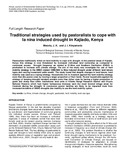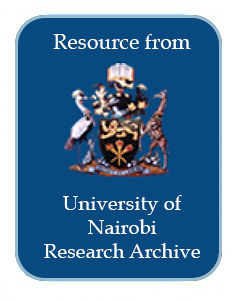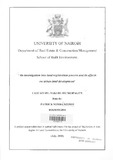Location
Our Vision is to be a world-class university committed to scholarly excellence.
Our Mission is to provide quality university education and training and to embody the aspirations of the Kenyan people and the global community through creation, preservation, integration, transmission and utilization of knowledge.
Core Values
In order to realize the above vision and mission, certain shared values shall be nurtured. There is great need for the University to be guided by the right values derived from the virtues and moral standards of the Kenyan and wider society.
Core Functions
Teaching and Learning: The university offers innovative , relevant and market driven academic programmes , both at undergraduate and postgraduate levels with inbuilt quality control systems the university also provides an environment and policy framework for undertaking high quality and relevant research
Members:
Resources
Displaying 161 - 165 of 298Rahani: A Unique Commercial Land Tenure Arrangement Amongst the Digo of Kenya's Coast
Land ownership, distribution, utilisation and exchange amongst the Digo people of Kenya's lower Coast is done through both formal systems and informal arrangements, 'Rahani'is an informal arrangement that allows landowners to rent out their excess or idle land at a price over an uncertain duration. Using data from several classes of respondents, this paper found that landowners practices 'rahani'to get quick money to attend to immediate domestic, personal and welfare problems. The negative impacts of 'rahani' include the possibility of loss and misuse of the rented land.
Traditional strategies used by pastoralists to cope with la nina induced drought in Kajiado, Kenya
Pastoralists traditionally relied on herd mobility to cope with drought. In the pastoral areas of Kajiado,
Kenya this strategy is now threatened by increased individual land ownership as compared to
communal access. Drought frequency as related to El-Nino and Southern Oscillation (ENSO) is
predicated to increase with climate change. The aim of the study was investigate the use of herd
mobility strategy in the ENSO related 1999/2000 la Nina induced drought under different land tenure
Effects of land use change on soil qualities in Sasumua catchment
Sustainability of natural resource base is dependent on good land management. Land use change
from forest to agricultural land can endanger sustainability of soil productivity if not well
managed. Effects of land use change from forest to annual crop cultivation and grazing on soil
qualities were investigated in Sasumua catchment with the aim of (a) determining the changes in
selected physical and chemical qualities (b) establishing how various soil quality indicators vary
Effects Of Land Use Change On Soil Qualities In The Sasumua Catchment Of Tana River Drainage System In Nyandarua District, Kenya
Effects of land use conversion from forest (F) to annual crop cultivation (AC) and grazing land (LG) on soil qualities were investigated in Sasumua catchment with the aim of (a) determining the changes in selected physical and chemical qualities (b) establishing how various soil [1]quality indicators varied with different land management practices and (c) developing the minimum data set for determination of soil health.
An Investigation Into Land Registration Process and Its Effects on Urban Land Development
The history of land policies from the time of colonial administrators to the time of development planners and reform programmes (resettlement schemes, adjudication and demarcation for registration purposes) underscores the history of most Kenyan citizens losing their rights and access to land and its commitant benefits.





